p.581
p.585
p.589
p.593
p.597
p.601
p.605
p.609
p.613
Effects of Torsional Plastic Deformation on Fatigue Strength in Copper and Aluminum
Abstract:
If the crystal grain size of a metal is made smaller, its strength is higher. So, many methods of grain refinement have been proposed. In this study, from the viewpoint of basic plastic working, the variations of static ultimate tensile strength and fatigue strength after the application of plastic torsional deformation on face centered cubic crystal metals, that are, aluminum and copper, were investigated. Tensile test, Vickers harness test and Rotating bending fatigue test were performed. The hardness of the materials varied from surface layer to center section in cross sectional area. In the case of aluminum, the tensile strength and fatigue limit were improved after application of torsional deformation. However, in the case of copper, the fatigue limit was not improved. This is strongly related to hardness distribution around the surface layer of the specimen. Also, it was found that the crack growth mode was changed by applying the pre-strain. From these results, one of an idea for improvement of material strength will be considered.
Info:
Periodical:
Pages:
597-600
Citation:
Online since:
November 2010
Authors:
Price:
Сopyright:
© 2011 Trans Tech Publications Ltd. All Rights Reserved
Share:
Citation:


